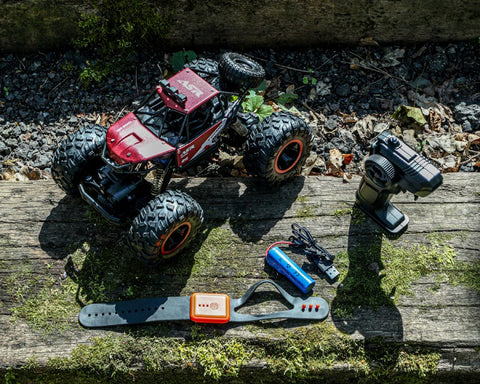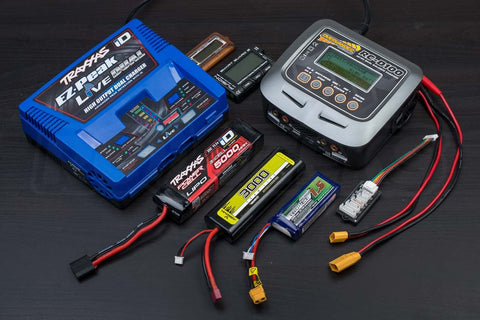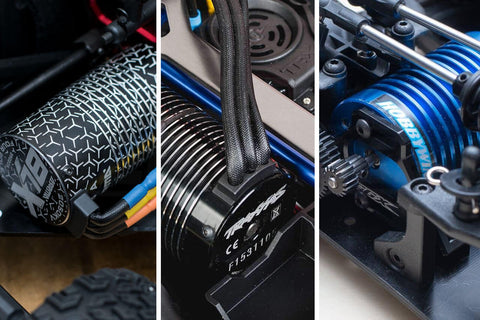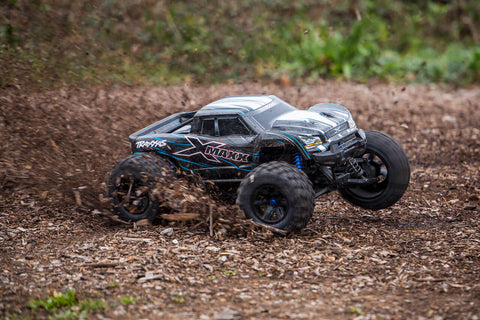The Taranis Q X7 is a 16 channel transmitter from control experts Fr Sky. We take a look at the features of the new controller and compare it with its big brother the Taranis Plus X9D, a current favourite for pilots of all types.

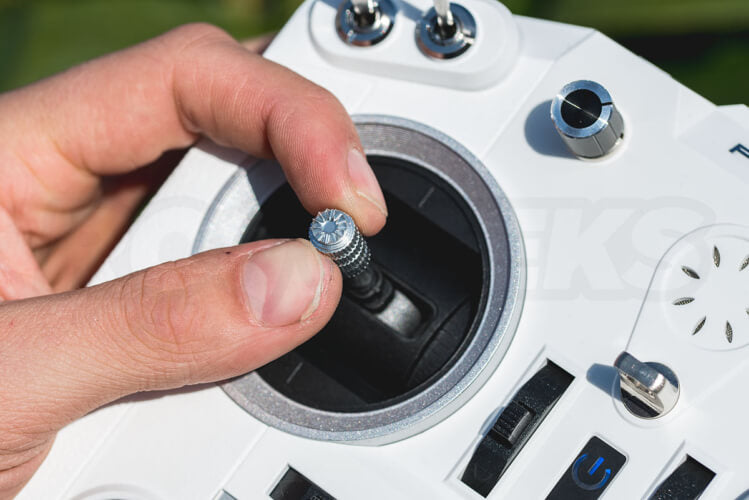 The X7 has two 2-position switches on the leading edge of the transmitter, the left one being a momentary switch.
The X7 has two 2-position switches on the leading edge of the transmitter, the left one being a momentary switch.  And four 3-position switches across the top front of the face.
And four 3-position switches across the top front of the face.  Lastly it has two pots on the front, of which the left has a central detent.
Lastly it has two pots on the front, of which the left has a central detent.  On top of this it has the standard trim switches, lanyard connector and metal loop handle on the rear. The transmitter features audio speech outputs as well as haptic alerts via its vibrating motor. It will store up to 60 models in its memory which is extendable thanks to its MicroSD slot.
On top of this it has the standard trim switches, lanyard connector and metal loop handle on the rear. The transmitter features audio speech outputs as well as haptic alerts via its vibrating motor. It will store up to 60 models in its memory which is extendable thanks to its MicroSD slot.
 The display, whilst smaller than the X9D is well designed. Out of the box the transmitter runs Open TX as seen on the twin splash screens.
The display, whilst smaller than the X9D is well designed. Out of the box the transmitter runs Open TX as seen on the twin splash screens.  The menu is activated, paginated and exited via the left set of buttons.
The menu is activated, paginated and exited via the left set of buttons.  But to navigate the menu you rotate the dial on the right hand side and push it in to select or alter the settings.
But to navigate the menu you rotate the dial on the right hand side and push it in to select or alter the settings. 

 The X9D follows the traditional but somewhat dated template for transmitter design. Its littered with switches, sliders, buttons and pots for adjusting its 16 channels of transmission. The bigger screen is easier to read at a glance and we feel has a better back-light for use in low light.
The X9D follows the traditional but somewhat dated template for transmitter design. Its littered with switches, sliders, buttons and pots for adjusting its 16 channels of transmission. The bigger screen is easier to read at a glance and we feel has a better back-light for use in low light. 
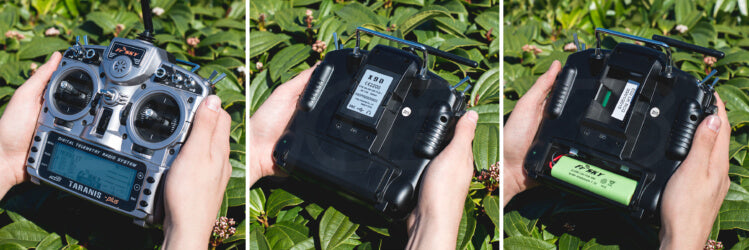 The new X7 features rubber grips on the rear (grey on both the black and white models) which felt secure in the hand and would stop the transmitter sliding across the surface when placed on a smooth desk. It features the same sized module port on the back with removable lid.
The new X7 features rubber grips on the rear (grey on both the black and white models) which felt secure in the hand and would stop the transmitter sliding across the surface when placed on a smooth desk. It features the same sized module port on the back with removable lid.  The new transmitter comes with a 6xAA battery tray installed in the rear, this is removable. The resulting cavity is taller and shallower measuring 92mm x 57mm x 16mm deep, although when selecting a cell to fit, bear in mind to calculate the space required for the battery lead.
The new transmitter comes with a 6xAA battery tray installed in the rear, this is removable. The resulting cavity is taller and shallower measuring 92mm x 57mm x 16mm deep, although when selecting a cell to fit, bear in mind to calculate the space required for the battery lead.
 Whereas the X7 splits the setup, the headphone jack and trainer port are on the top of the transmitter.
Whereas the X7 splits the setup, the headphone jack and trainer port are on the top of the transmitter.  Whilst the MicroSD card slot, USB port and smart port are found under a rubberised cover on the base of the controller.
Whilst the MicroSD card slot, USB port and smart port are found under a rubberised cover on the base of the controller.  This is less favourable for those who regularly use the USB port for simulators as the plug will protrude into their abdomen/desk surface or anything below the controller.
This is less favourable for those who regularly use the USB port for simulators as the plug will protrude into their abdomen/desk surface or anything below the controller.

In the Box
The Q X7 is quite spartan with its packaging. A cardboard box gives way to a moulded polystyrene insert with the transmitter in a plastic bag. It does include a nice lanyard with balance adapter, the manual and some stickers
Taranis Q X7 Features
The transmitter features quad ball bearing gimbals with great feel. Note that if you are handy with a screwdriver the feel of these can be customised to your particular tastes in terms of resistance or ratchet (more on that later). Its electronics and radio were designed for super low latency. As with the X9D it features signal strength indication technology and real-time flight data logging. The X7 has two 2-position switches on the leading edge of the transmitter, the left one being a momentary switch.
The X7 has two 2-position switches on the leading edge of the transmitter, the left one being a momentary switch.  And four 3-position switches across the top front of the face.
And four 3-position switches across the top front of the face.  Lastly it has two pots on the front, of which the left has a central detent.
Lastly it has two pots on the front, of which the left has a central detent.  On top of this it has the standard trim switches, lanyard connector and metal loop handle on the rear. The transmitter features audio speech outputs as well as haptic alerts via its vibrating motor. It will store up to 60 models in its memory which is extendable thanks to its MicroSD slot.
On top of this it has the standard trim switches, lanyard connector and metal loop handle on the rear. The transmitter features audio speech outputs as well as haptic alerts via its vibrating motor. It will store up to 60 models in its memory which is extendable thanks to its MicroSD slot.
Configuring the Q X7
 The display, whilst smaller than the X9D is well designed. Out of the box the transmitter runs Open TX as seen on the twin splash screens.
The display, whilst smaller than the X9D is well designed. Out of the box the transmitter runs Open TX as seen on the twin splash screens.  The menu is activated, paginated and exited via the left set of buttons.
The menu is activated, paginated and exited via the left set of buttons.  But to navigate the menu you rotate the dial on the right hand side and push it in to select or alter the settings.
But to navigate the menu you rotate the dial on the right hand side and push it in to select or alter the settings. 
X7 vs X9D : Comparison

X7 vs X9D : Ergonomics
At first glance the X7 with its hard angles and chamfered edges looks like it is going to be uncomfortable in the hand. In reality its light weight wide body is quite comfortable. The texture plastic sides and front provide friction for your hands enabling your to pinch the gimbals and support the transmitter even without using a lanyard to assist with the load. The X9D follows the traditional but somewhat dated template for transmitter design. Its littered with switches, sliders, buttons and pots for adjusting its 16 channels of transmission. The bigger screen is easier to read at a glance and we feel has a better back-light for use in low light.
The X9D follows the traditional but somewhat dated template for transmitter design. Its littered with switches, sliders, buttons and pots for adjusting its 16 channels of transmission. The bigger screen is easier to read at a glance and we feel has a better back-light for use in low light. 
X7 vs X9D : Battery Tray
 The new X7 features rubber grips on the rear (grey on both the black and white models) which felt secure in the hand and would stop the transmitter sliding across the surface when placed on a smooth desk. It features the same sized module port on the back with removable lid.
The new X7 features rubber grips on the rear (grey on both the black and white models) which felt secure in the hand and would stop the transmitter sliding across the surface when placed on a smooth desk. It features the same sized module port on the back with removable lid.  The new transmitter comes with a 6xAA battery tray installed in the rear, this is removable. The resulting cavity is taller and shallower measuring 92mm x 57mm x 16mm deep, although when selecting a cell to fit, bear in mind to calculate the space required for the battery lead.
The new transmitter comes with a 6xAA battery tray installed in the rear, this is removable. The resulting cavity is taller and shallower measuring 92mm x 57mm x 16mm deep, although when selecting a cell to fit, bear in mind to calculate the space required for the battery lead.
X7 vs X9D : Ports and plugs
The X9D has the trainer, headphone and USB ports on the back of the transmitter around a 3rd of the way up. The MicroSD card slot is hidden away under the battery flap and requires the battery to be removed before it can be ejected. Whereas the X7 splits the setup, the headphone jack and trainer port are on the top of the transmitter.
Whereas the X7 splits the setup, the headphone jack and trainer port are on the top of the transmitter.  Whilst the MicroSD card slot, USB port and smart port are found under a rubberised cover on the base of the controller.
Whilst the MicroSD card slot, USB port and smart port are found under a rubberised cover on the base of the controller.  This is less favourable for those who regularly use the USB port for simulators as the plug will protrude into their abdomen/desk surface or anything below the controller.
This is less favourable for those who regularly use the USB port for simulators as the plug will protrude into their abdomen/desk surface or anything below the controller.
X7 vs X9D : New power button
As pictured below, the Taranis Q X7 has a 'soft' power button compared to the X9D's standard switch. This new button requires you to press and hold the button for 4 seconds to power down the transmitter, adding an extra layer of protection against accidental power downs. In use (with the lanyard strap balanced attached over the power button) it is unlikely that you would accidentally knock the power switch down.
Taranis Q X7 Customisation
We know a lot of enthusiasts are keen to modify their transmitters and FrSky have seemingly considered this when designing the X7. The battery tray is removed by unscrewing two screws and unplugging it, leaving a cavity free for a 2s or 3s LiPo battery. The actual housing is simple to open up should you want to adjust the gimbal resistance or feel (smooth tensioned or ratchet) by adjusting a couple of screws on the back of the pots. Helpfully all the pots and switches are secured to the front face of the transmitter so taking the back off doesn't result in them falling out. The new flat style 2dB antenna plugs into a daughter board which makes it easier to switch out should you wish to change it. The unit can be configured for modes 1, 2, 3 or 4 and the left 'throttle' stick comes setup sprung loaded. This isn't for everyone but it is relatively straight forward to disable following this video by FrSky themselves. However the long metal screws torquing into plastic suggests that this isn't something you'd like to regularly adjust. Finally we have seen a lot of interest in the FrSky hall sensor gimbals for the X9D and this is a modification that can be carried out on the Q X7 too. If you are interested in the modification potential of the Q X7 then the RC Groups forum has this fantastic thread covering pretty much every angle.Should I buy A Taranis Q X7 or a Taranis Plus X9?
Everyone has individual needs; The vast majority of people considering this transmitter will be on a budget and for the money it offers incredible value. Its ideal for anyone looking for a controller that supports Open TX and its community. Thus if you are on a budget, looking for something fresh, or just have large hands, the Q X7 could well be the transmitter for you. Its big brother the X9 has more switches and includes sliders, important if you are looking to use the transmitter to finely control a gimbal say for aerial photography. Also the location of the USB ad trainer ports (on the back rather than the bottom) makes it more suitable for prolonged use in simulators. That said users in the past have reported issues with the speaker buzzing and the slightly dated looks.Taranis Q X7 Conclusions
We like- The comparatively low price
- Quality gimbals (easily adjustable in terms of return spring pressure and resistance/ratchet)
- New rotary dial for working through the menu
- Wide design with soft grips is ideal for larger hands
- Safety soft power switch
- The aesthetic (which has proven quite polarising)
- No battery (and battery tray size is small) standard 6x double AA battery tray included
- No fancy aluminium case like its bigger brother
- No SD Card included (required)
- Smaller, lower resolution screen
- No side sliders (traditionally used for gimbals)






